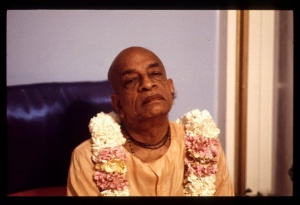SB 3.26.14: Difference between revisions
m (1 revision(s)) |
No edit summary |
||
| Line 1: | Line 1: | ||
{{info | {{info | ||
|speaker=Lord Kapiladeva the Supreme Personaliy of Godhead | |speaker=Lord Kapiladeva the Supreme Personaliy of Godhead | ||
|listener=Devahūti, mother of Lord Kapiladeva | |listener=Devahūti, mother of Lord Kapiladeva | ||
}} | }} | ||
[[Category:Srimad-Bhagavatam - Canto 03 Chapter 26]] | |||
[[Category:Bhagavatam Verses Spoken by Lord Kapila - Vanisource|032614]] | |||
<div style="float:left">'''[[Srimad-Bhagavatam]] - [[SB 3|Third Canto]] - [[SB 3.26: Fundamental Principles of Material Nature|Chapter 26: Fundamental Principles of Material Nature]]'''</div> | |||
<div style="float:right">[[File:Go-previous.png|link=SB 3.26.13]] '''[[SB 3.26.13]] - [[SB 3.26.15]]''' [[File:Go-next.png|link=SB 3.26.15]]</div> | |||
{{RandomImage}} | |||
==== TEXT 14 ==== | ==== TEXT 14 ==== | ||
<div | <div class="verse"> | ||
mano buddhir ahaṅkāraś | :mano buddhir ahaṅkāraś | ||
cittam ity antar-ātmakam | :cittam ity antar-ātmakam | ||
caturdhā lakṣyate bhedo | :caturdhā lakṣyate bhedo | ||
vṛttyā lakṣaṇa-rūpayā | :vṛttyā lakṣaṇa-rūpayā | ||
</div> | </div> | ||
| Line 16: | Line 22: | ||
==== SYNONYMS ==== | ==== SYNONYMS ==== | ||
<div | <div class="synonyms"> | ||
''manaḥ''—the mind; ''buddhiḥ''—intelligence; ''ahaṅkāraḥ''—ego; ''cittam''—consciousness; ''iti''—thus; ''antaḥ-ātmakam''—the internal, subtle senses; ''catuḥ-dhā''—having four aspects; ''lakṣyate''—is observed; ''bhedaḥ''—the distinction; ''vṛttyā''—by their functions; ''lakṣaṇa-rūpayā''—representing different characteristics. | |||
</div> | </div> | ||
| Line 23: | Line 29: | ||
==== TRANSLATION ==== | ==== TRANSLATION ==== | ||
<div | <div class="translation"> | ||
The internal, subtle senses are experienced as having four aspects, in the shape of mind, intelligence, ego and contaminated consciousness. Distinctions between them can be made only by different functions, since they represent different characteristics. | The internal, subtle senses are experienced as having four aspects, in the shape of mind, intelligence, ego and contaminated consciousness. Distinctions between them can be made only by different functions, since they represent different characteristics. | ||
</div> | </div> | ||
| Line 30: | Line 36: | ||
==== PURPORT ==== | ==== PURPORT ==== | ||
<div | <div class="purport"> | ||
The four internal senses, or subtle senses, described herein are defined by different characteristics. When pure consciousness is polluted by material contamination and when identification with the body becomes prominent, one is said to be situated under false ego. Consciousness is the function of the soul, and therefore behind consciousness there is soul. Consciousness polluted by material contamination is called ahaṅkāra. | The four internal senses, or subtle senses, described herein are defined by different characteristics. When pure consciousness is polluted by material contamination and when identification with the body becomes prominent, one is said to be situated under false ego. Consciousness is the function of the soul, and therefore behind consciousness there is soul. Consciousness polluted by material contamination is called ''ahaṅkāra''. | ||
</div> | </div> | ||
__NOTOC__ | |||
<div style="float:right; clear:both;">[[File:Go-previous.png|link=SB 3.26.13]] '''[[SB 3.26.13]] - [[SB 3.26.15]]''' [[File:Go-next.png|link=SB 3.26.15]]</div> | |||
__NOTOC__ | |||
__NOEDITSECTION__ | |||
Revision as of 09:25, 8 May 2021

A.C. Bhaktivedanta Swami Prabhupada
TEXT 14
- mano buddhir ahaṅkāraś
- cittam ity antar-ātmakam
- caturdhā lakṣyate bhedo
- vṛttyā lakṣaṇa-rūpayā
SYNONYMS
manaḥ—the mind; buddhiḥ—intelligence; ahaṅkāraḥ—ego; cittam—consciousness; iti—thus; antaḥ-ātmakam—the internal, subtle senses; catuḥ-dhā—having four aspects; lakṣyate—is observed; bhedaḥ—the distinction; vṛttyā—by their functions; lakṣaṇa-rūpayā—representing different characteristics.
TRANSLATION
The internal, subtle senses are experienced as having four aspects, in the shape of mind, intelligence, ego and contaminated consciousness. Distinctions between them can be made only by different functions, since they represent different characteristics.
PURPORT
The four internal senses, or subtle senses, described herein are defined by different characteristics. When pure consciousness is polluted by material contamination and when identification with the body becomes prominent, one is said to be situated under false ego. Consciousness is the function of the soul, and therefore behind consciousness there is soul. Consciousness polluted by material contamination is called ahaṅkāra.